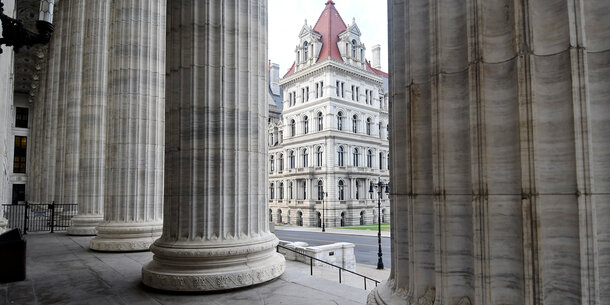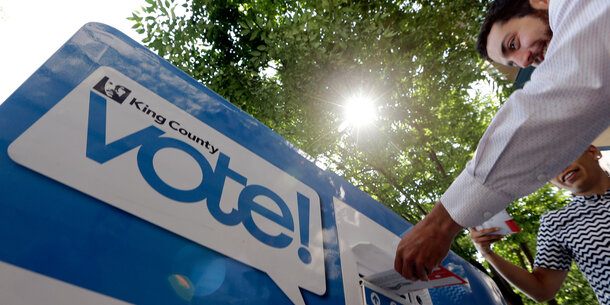New York’s new small donor public financing law promises to be remarkably effective in transforming the state’s big donor–dominated elections to empower everyday citizens, a new analysis shows. Had the program been available for last year’s state legislative elections, small donors (giving $250 or less) could have made up 61 percent of all funds raised by candidates, instead of just 13 percent. 1 As it was, small donors were far outweighed by large individual donors and entity donors such as corporations.
Lawmakers enacted the voluntary program last year to launch in November 2022. They will need to include modest funds to build the program’s infrastructure in this April’s budget to deliver the reform on time.
The reform will boost the political influence of a greater diversity of New Yorkers and enable candidates with strong public support to raise competitive sums by relying on their constituents rather than big donors. It will do so by multiplying small donations from New Yorkers to qualified candidates who choose to participate with public matching funds. As elected officials confront crises from housing to healthcare to education, the need to amplify more New Yorkers’ voices in the political process is greater than ever.
Combined with recently enacted voting reforms, including automatic voter registration, New York’s adoption of small donor public financing puts it at the forefront of expanding participation just as a national battle rages over the very question of who counts in American democracy. A similar package of voting and campaign finance reforms passed the U.S. House of Representatives this March and awaits a vote in the U.S. Senate.
As Ekow Yankah, chair of the new board overseeing New York’s public financing initiative, has said, “Together, these reforms will give New Yorkers a greater stake in their democracy, regardless of background or means, and deepen candidates’ commitment to their constituents.”
The Potential Efficacy of Small Donor Public Financing in New York State
Analysis based on donations to New York state candidates in 2020 by the nonpartisan Campaign Finance Institute (CFI), a division of the National Institute on Money in Politics, shows the transformative potential of the new law, as the following figures 1 and 2 show.
Under the current campaign finance system (figure 1), small donors are drowned out by large individual donors and entity donors. Small donors giving $250 or less to candidates for the New York State legislature in 2020 made up only 13 percent of total fundraising.
Applying the new public financing law (figure 2), small-donor New Yorkers become nearly five times more important than they were under the status quo system. With the reform, small donors account for 61 percent of funds raised by legislative candidates rather than just 13 percent.
This projection makes two sensible assumptions. 2 First, it assumes that all candidates in 2020 who would have raised as much money as they did, or more, using public financing — the vast majority raised more under the reform — would choose to participate. 3
Next, the projection assumes that a modestly greater number of small donors would contribute under public financing than without public financing. 4 It makes sense to assume greater participation by small donors, because the reform is designed to incentivize candidates to seek more support from their constituents and because areas where similar programs operate have seen more people participate as small donors. But even assuming zero additional small donors participated, which is unrealistic, small donors still would account for a significantly greater share of fundraising under public financing than they did without public financing: 42 percent instead of 13 percent. 5
Why Amplifying Small Donors Matters to Democracy
The relative influence of small donors versus large individual or corporate donors has important socioeconomic equity implications. Research shows that donors enjoy greater access to elected officials than nondonors do. 6 This access may influence policy decisions to align more closely with the policy preferences of donors than the policy preferences of the majority of constituents. 7 Yet large donors as a group are unrepresentative of constituents, generally, as they overwhelmingly tend to be wealthy, white, and male. 8
Small donors tend to be much more representative of the general electorate. Public financing programs serve to boost that representativeness. Small donors to New York City council candidates under public financing were more likely to be racially and economically representative of the city’s population than small donors to state candidates who did not have a public financing program. In Berkeley, California, donor participation increased in every zip code after the enactment of the city’s public financing program. Donors from more neighborhoods participated in Los Angeles’s first municipal election with public financing than before public financing.
Our study of congressional fundraising shows that small donor public financing is also a tool to overcome barriers for socioeconomically disadvantaged candidates. Candidates who are women and people of color — groups underrepresented in Congress — rely more on small donors than their white and/or male opponents. Women of color in particular face a persistent fundraising deficit compared to other candidates, due to systemic barriers to accessing wealthy donors. A small donor public financing program in the U.S. House general elections from 2012 to 2018 would have enabled women of color candidates to shrink their fundraising deficit by 34 percent in 2018 alone, while enabling all candidates across the entire period to raise competitive sums based on the support of everyday constituents.
Of the largest individual donors in New York’s 2020 state legislative races (those who gave $5,000 or more, each), nearly 90 percent hailed from areas with better employment rates than the state average. 9 These largest donors made the majority of their contributions during the Covid-19 pandemic, while everyday New Yorkers experienced a sharp increase in joblessness, hunger, and housing insecurity. 10
Background on New York’s New Small Donor Public Financing Program and Its Current Status
New York’s new small donor public financing law is the most powerful legislative response by any state to the Supreme Court’s 2010 Citizens United decision, which supercharged big money in politics. The law significantly reduces contribution limits for all candidates, whether or not they choose to participate in public financing. It enables candidates for state legislature and statewide offices to receive a multiple match on small contributions they raise from constituents, if they first prove a sufficient level of public support and agree to the program’s rules. The size of the match and maximum amount of public matching funds a candidate can receive vary by office. The program imposes certain cost-controlling measures to ensure public funds are not wasted.
Innovative features of New York’s new program respond to special concerns of fundraising in the super PAC era. From the candidates’ perspective, the ability to keep raising unmatched contributions if they reach their public financing maximum frees them to respond, if necessary, to independent spending while still drawing most of their support from constituents. From the perspective of New Yorkers who struggle to be heard alongside big donors, the program’s higher match for the smallest contributions to legislative candidates is an important boost.
(See our Guide: New York State’s New Small Donor Public Financing Program for specifics about contribution limits, requirements for candidates to be able to earn matching funds, match ratios, maximum public funds per office, and other details.)Lawmakers have taken the first steps to ready this progressive democracy reform. Legislative leaders of both major parties have appointed members to the newly created Public Campaign Finance Board. Those members have declared their bipartisan commitment “to prepare the program for a successful launch in November 2022.” The board has the necessary number of members to act even with a vacancy to be filled by the governor. And the executive and legislative budget proposals all included the agency’s request for implementation funds.
This new analysis shows that New York’s small donor public financing law will be effective in increasing representativeness in the state’s elections. Lawmakers need to deliver on their proposals to fund the program’s creation in time for participation to begin next year.
Endnotes
-
1
The Campaign Finance Institute, a division of the nonpartisan National Institute on Money in Politics, performed the data collection and analyses discussed throughout this writing except where otherwise noted. -
2
For more details about the methodology of these projections, please see Michael Malbin and Brendan Glavin, Small Donor Public Finance in New York State: Major Innovations – With a Catch, Campaign Finance Institute, National Institute on Money in Politics, January 2020, 20, http://cfinst.org/pdf/state/ny/Small-Dono r-Public-Finance-in-NY_Jan2020.pdf. -
3
Applying the public financing model, 84 percent of senators and more than 90 percent of assembly members would have raised more using the reform than they did without the reform, even without finding new donors, according to a new analysis that the Campaign Finance Institute provided to the Brennan Center. -
4
Malbin et al., Small Donor Public Finance, 9. -
5
Campaign Finance Institute projection of candidate fundraising for New York State legislators under the enacted public financing program, assuming the same number of donors. -
6
Joshua L. Kalla and David E. Broockman, “Campaign Contributions Facilitate Access to Congressional Officials: A Randomized Field Experiment,” American Journal of Political Science 60, no.3 (2016): 553, https://onlinelibrary.wiley.com/doi/pdf/10.1111/ajps.12180. -
7
Brandice Canes-Wrone & Nathan Gibson, “Does Money Buy Congressional Love? Individual Donors and Legislative Voting,” Congress & the Presidency 46, no. 1 (2019): 14–15; Martin Gilens and Benjamin I. Page, “Testing Theories of American Politics: Elites, Interest Groups, and Average Citizens,” Perspectives on Politics 12, no. 3 (2014): 572, 575, https://scholar.princeton.edu/sites/default/files/mgilens/files/gilens_and_ page_2014_-testing_theories_of_american_politics. doc.pdf. -
8
See also Abhay Aneja, Jacob Grumbach, and Abby Wood, “Financial Inclusion in Politics,” Center for Law and Social Science Research Paper Series No. CLASS21–3, Legal Studies Research Paper Series No. 21–3 (2020): 18, https://papers.ssrn.com/sol3/papers.cfm?abstract_id=3767092. -
9
Of these biggest donors, 88 percent were from counties where the unemployment rate was lower than the January 2021 statewide average for New York State of 8.8 percent. To produce this finding, we aggregated donations made during the 2020 election cycle by each individual donor, to identify those individuals who gave $5,000 or more in total. We cross-referenced county-level location data of these biggest donors as provided by the National Institute on Money in Politics with county-level unemployment rate statistics for January 2021 from the U.S. Bureau of Labor Statistics. See United States Bureau of Labor Statistics “Local Area Unemployment Statistics,” accessed March 23, 2021, https://data.bls.gov/PDQWeb/la. -
10
These biggest donors, of $5,000 or more each in aggregate, made 57 percent of these donations after March 11, 2020, the day the World Health Organization declared a global pandemic. See Bill Chappell, “Coronavirus: COVID-19 Is Now Officially A Pandemic, WHO says,” NPR, March 11, 2020, https://www.npr.org/sections/goatsandsoda/2020/03/11/814474930/coronavirus-covid-19-is-now-officially-a-pandemic-who-says. This analysis was completed by disaggregating the contributions for each individual donor giving $5,000 or more in total by date of contribution. Donations that were dated after March 11, 2020 were then totaled.



